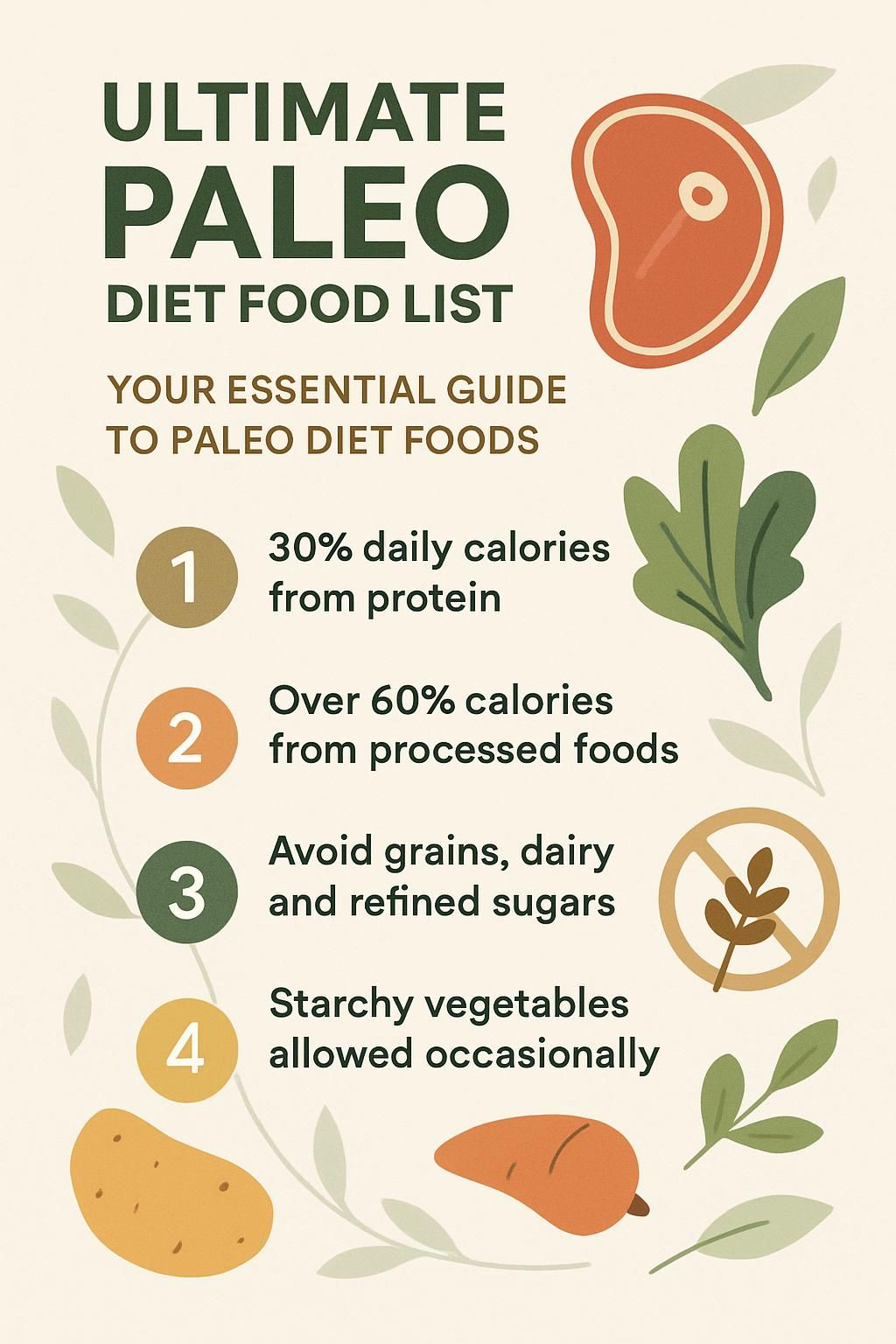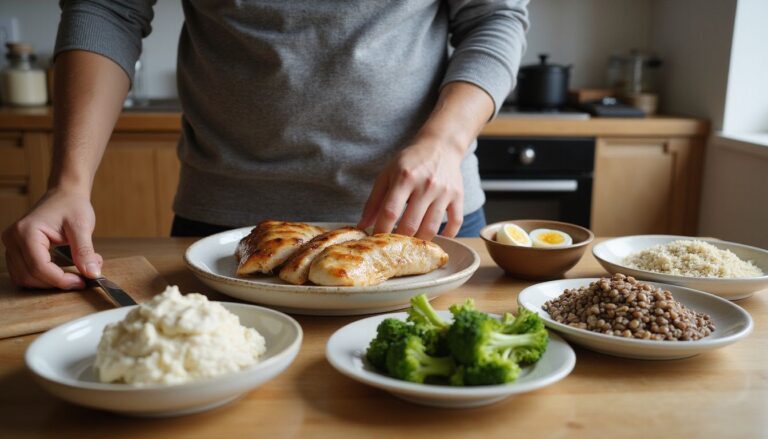Ultimate Paleo Diet Food List: Your Essential Guide To Paleo Diet Foods
Our Nutrition Assistant AI Suite will transform your body. You will lose fat, get toned, and build muscle. Gain confidence and optimal health.
Finding a clear Paleo diet food list can feel confusing. Advice varies, and it is easy to overthink every choice. I learned that following a simple plan of whole foods can lift energy and reduce processed snacks without making life harder.
This guide explains core principles, foods to eat, and foods to avoid on the paleo diet. I use plain language, quick lists, and research summaries so healthy choices feel doable.
Key Takeaways
- The paleo diet centers on lean meats, fish, eggs, vegetables, fruits, nuts, and healthy fats. It excludes grains, legumes, most dairy, refined sugars, and ultra-processed foods (Cordain et al., 2005).
- A trial in The American Journal of Clinical Nutrition (2010) found paleo-style meals reduced blood sugar spikes and supported weight loss compared with a typical Western diet.
- Many experts suggest a higher protein intake, around 25 to 30 percent of calories, from sources like grass-fed beef or wild-caught salmon.
- USDA data shows Americans get over 60 percent of calories from ultra-processed foods. Shifting to whole foods may lower inflammation risk.
- Occasional paleo-friendly choices include starchy vegetables like sweet potatoes and limited natural sweeteners such as raw honey or maple syrup.

Basics of the Paleo Diet Explained

The idea behind the paleo diet is simple. Eat foods similar to what hunter gatherers had, then skip modern staples that are highly processed. That means focusing on whole foods like meat, seafood, vegetables, fruits, nuts, and seeds.
A 2010 study in The American Journal of Clinical Nutrition reported that paleo meals improved blood sugar control and supported weight loss versus a standard Western pattern. Many people also report fewer afternoon energy crashes after switching to whole foods.
Most strict plans exclude grains such as wheat and rice, legumes like beans and peanuts, dairy, refined sugars, and heavily processed snacks. Some people also limit white potatoes and added salt, especially early on.
For me, a basic meal plan built on allowed foods steadied my energy during long workdays.
Eat real food, not too much, and mostly plants.
Researchers including Dr. Loren Cordain suggest that returning to simple whole foods can support digestion and may lower inflammation linked with chronic disease.
What Are the Core Principles of the Paleo Diet?
The paleo diet is based on whole foods our ancestors could have gathered or hunted. I focus on lean meats, seafood, eggs, vegetables, fruits, nuts, and fats from olives, avocados, or coconuts.
The plan avoids ultra-processed foods, added sugar, grains, legumes, most dairy, and many seed oils. Some people notice fewer digestive issues after dropping grains and legumes, which contain antinutrients like lectins and phytates. These can reduce mineral absorption in some people.
Protein is higher than in many modern diets, often near 30 percent of calories. Carbohydrates are generally lower, but fiber stays high because vegetables and fruits are staples.
When I first tried a stricter plan, I swapped bread for fruit at breakfast and used grass-fed beef or wild salmon at lunch. My energy stayed steady for the rest of the day.
Eating this way helps me choose nutrient-dense foods while avoiding ingredients linked with weight gain and metabolic problems.
Essential Paleo Diet Foods
This section gives you a practical paleo food list you can use right away.
What Meat and Poultry Are Best for Paleo?
Lean, unprocessed meats fit best. I build meals around these simple options.
- Grass-fed beef contains more omega 3 fats than grain-fed beef and adds variety to my meals.
- Wild game like venison or bison is lean, high in protein, and rich in iron.
- Pasture-raised chicken often has more vitamin E and a balanced fat profile.
- Turkey is a lean protein that works well in soups, salads, or roasts.
- Pork from pasture-raised pigs provides healthier fats. Choose plain cuts like chops or tenderloin.
- Duck has a rich flavor and supplies zinc and selenium when sourced well.
- Lamb raised on grass offers a balanced mix of fatty acids for dinner rotation.
Next, I look at seafood for heart and brain benefits.
Which Seafood Options Fit the Paleo Diet?
Seafood offers protein, healthy fats, and key minerals. Wild-caught fish are closest to a traditional pattern.
- Wild salmon supplies omega 3s that support the heart and brain.
- Sardines are rich in calcium and vitamin D for strong bones.
- Shrimp is low in calories and high in selenium, a protective mineral.
- Mackerel provides protein, healthy fats, and B vitamins for energy.
- Cod is a lean, versatile fish with low mercury.
- Oysters deliver zinc and iron to support immunity and oxygen transport.
- Tuna is protein-dense but should be limited due to mercury.
Next up are fruits that work well on paleo.
What Fruits Should You Eat on Paleo?
Fruits add vitamins, minerals, antioxidants, and fiber. I pick options that support steady energy.
- Berries like blueberries and strawberries are rich in antioxidants and lower in sugar.
- Apples and pears add fiber and help keep blood sugar stable.
- Bananas provide potassium and quick energy. I use them less often if I am cutting carbs.
- Citrus fruits such as oranges and grapefruit deliver vitamin C and bright flavor.
- Melons hydrate well after workouts due to high water content.
- Stone fruits, including peaches and cherries, bring a broad vitamin mix.
- Avocados are unique fruits high in healthy fats. I mash them into sauces.
- Pineapple contains the enzyme bromelain, which supports digestion for some people.
- Kiwi offers vitamin C and potassium with moderate sugar.
- Mango is higher in natural sugar, so I keep portions small during weight loss.
These choices fit any simple paleo meal plan and keep meals colorful.
What Vegetables Are Paleo-Friendly?
Vegetables are the foundation of my plate. I mix types to cover nutrients.
- Leafy greens like spinach, kale, and romaine are high in magnesium and fiber.
- Cruciferous vegetables such as broccoli and cauliflower bring vitamin C and support gut health.
- Root vegetables like carrots and beets add minerals and a touch of natural sweetness.
- Zucchini and summer squash are light and versatile in sautés or salads.
- Asparagus contains prebiotic fiber that feeds helpful gut bacteria.
- Bell peppers add color, vitamin C, and carotenoids.
- Mushrooms add umami flavor and B vitamins for energy.
- Onions and garlic boost flavor and may help lower inflammation.
- Cucumbers hydrate, which supports a healthy digestive tract.
Which Nuts and Seeds Are Allowed on Paleo?
Nuts and seeds supply healthy fats, protein, and minerals. I keep portions modest since they are calorie dense.
- Almonds are high in vitamin E and magnesium. Raw almonds make a handy snack.
- Walnuts provide plant omega 3 fats that support heart health.
- Macadamia nuts are rich in monounsaturated fat and lower in carbs.
- Cashews fit in moderation and work in sauces and trail mixes.
- Pumpkin seeds offer zinc and iron. I choose unsalted versions.
- Sunflower seeds bring vitamin E and a crunchy texture.
- Hazelnuts add antioxidants and pair well with salads.
- Pecans deliver satisfying flavor without added sugar.
- Brazil nuts are an excellent source of selenium for immune support.
Keeping a small pack of mixed raw nuts at my desk helps me skip candy and stay focused through busy afternoons.
What Are Healthy Fats and Oils for Paleo?
Fat is fuel on paleo. I choose options that work for cooking and salads.
- Extra virgin olive oil is rich in monounsaturated fat and antioxidants. I use it for dressings and low heat cooking.
- Coconut oil tolerates heat well and works for baking or sautés.
- Avocado oil has a high smoke point and a mild taste for roasting.
- Animal fats like tallow or duck fat, ideally from grass-fed sources, can be used for high heat cooking.
- Use nuts like macadamias and almonds for fat, but skip industrial seed oils like soybean, corn, or canola when possible.
- Ghee, clarified butter with milk solids removed, may fit some less strict plans.
- Walnut or flax oils add omega 3s to cold dishes. I avoid heating them.
- Avoid margarine and shortening since they can contain trans fats.
During my first week, I cooked eggs and skillet sweet potatoes in coconut oil. It heated quickly and did not smoke.
Which Herbs and Spices Enhance Paleo Meals?
Herbs and spices add flavor and antioxidants. I use them daily to keep meals interesting.
- Basil brightens salads and grilled chicken, and it contains vitamin K.
- Thyme pairs with roasted meats and may support digestion.
- Rosemary works well with lamb or chicken and adds a pine-like aroma.
- Parsley brings vitamin C, vitamin A, and folate. I add it just before serving.
- Cinnamon adds gentle sweetness and may help regulate blood sugar.
- Turmeric supplies curcumin, an anti-inflammatory compound. I stir it into soups.
- Garlic boosts aroma and may support heart and immune health.
- Cilantro adds citrus notes and minerals like potassium and magnesium.
Now, here are beverages that fit the plan.
What Beverages Are Suitable for Paleo?
Your drink choices matter. They can help you stay hydrated and avoid hidden sugar.
- Water is my main drink all day.
- Black coffee fits if I skip sugar and creamers. Moderate intake can help with focus.
- Herbal teas like peppermint or chamomile are caffeine free and simple.
- Coconut water contains electrolytes. I choose versions without added sugar.
- Unsweetened almond or coconut milk can replace dairy in recipes.
- Fruit infused water adds flavor with lemon slices or berries.
- Some people allow an occasional glass of dry wine, but less alcohol is usually better for health.
- Fresh vegetable juices without added sweeteners can add vitamins, especially with leafy greens.
I often make herbal tea at night. It supports my routine without extra sugar.
Foods to Avoid on the Paleo Diet
Some foods work against the plan. Here is what I skip to stay on track.
Why Should You Avoid Grains on Paleo?
Grains can contain gluten, lectins, and phytates. These compounds are hard to digest for some people and can reduce mineral absorption.
High grain intake is linked with blood sugar spikes. Dropping grains helps me avoid energy crashes and makes weight loss easier because it supports steadier insulin levels.
When I cut bread, rice, and cereal, my digestion improved within a week. Grain free meals match the core idea of eating more like early humans and less like a modern snack aisle.
Which Legumes Are Not Allowed on Paleo?
Beans, lentils, peas, peanuts, soybeans, and chickpeas are off the list. They contain antinutrients, such as lectins and phytates, that can interfere with digestion in some people.
Even peanut butter is a legume product, so I skip it on a strict plan. A 2019 review in Nutrients notes that these compounds may cause issues for sensitive individuals. I focus on vegetables, nuts, seeds, animal proteins, and healthy fats instead.
What Dairy Products Are Excluded from Paleo?
Strict paleo plans avoid cow’s milk, cheese, yogurt, ice cream, and butter. Early humans did not rely on dairy animals for food sources, which is one reason traditional paleo excludes dairy [1]. Lactose, the milk sugar, can also cause digestive problems for many adults [2].
I noticed less bloating after removing milk based products. Some people choose ghee or small amounts of butter if they tolerate it, but those choices are part of modified versions, not strict paleo.
References:
1. Cordain L. et al., Origins and evolution of the Western diet, Am J Clin Nutr (2005).
2. Szilagyi A., Lactose Digestibility…, Nutrients (2015).
Why Avoid Processed Foods and Snacks?
Processed foods often contain added sugars, unhealthy fats, colors, and preservatives. They are made for long shelf life, not health.
USDA data shows that over 60 percent of the average American’s daily calories come from ultra-processed foods. These products can raise inflammation and increase risk for heart disease and type 2 diabetes.
Paleo skips packaged snacks in favor of fruit, vegetables, nuts, seafood, and simple meats. Swapping bar codes for whole foods helped me stay full and cut cravings.
Which Sugars Should You Dodge on Paleo?
Refined sugars, such as white sugar, high fructose corn syrup, and brown sugar, do not fit the plan. They spike blood sugar and can drive weight gain and inflammation.
I avoid sodas, candy, commercial baked goods, and syrups made from corn or rice. Artificial sweeteners like aspartame and sucralose also raise concerns because studies suggest they can disrupt gut bacteria [1]. Natural sweeteners, including honey and maple syrup, should be limited since they still raise blood sugar [2].
…
1. Suez J. et al., Nature 2014 (link).
2. CDC: Sugar facts (link).
What Alcoholic Drinks Should Be Limited?
Beer, cider, and most flavored liqueurs include grains or added sugars. Spirits like vodka, whiskey, rum, and gin are often grain or potato based. These can be irritating for some people and may slow fat loss.
Wine contains natural sugars. More than a small glass can trigger cravings for snacks in my case. Many keto plans also limit alcohol for similar reasons related to blood sugar and appetite.
Your body burns alcohol before fat, so frequent drinking can stall progress even if other meals follow this paleo diet food list closely.
Occasionally Acceptable Paleo Diet Foods
Some foods can fit in small amounts. I use them when I want flexibility without losing momentum.
What Starchy Vegetables Can You Occasionally Eat?
Starchy vegetables are higher in carbohydrates. I save them for active days or special meals.
- Sweet potatoes supply vitamin A and steady carbs for training days.
- Yams bring fiber and potassium. I serve them once or twice a week.
- Parsnips add vitamin C and variety to soups and roasts.
- Plantains make crunchy chips when pan fried in coconut oil.
- Winter squash like butternut delivers antioxidants and comfort food vibes.
- Taro offers magnesium and a change of pace.
- Beets provide folate and a hint of sweetness for salads.
Limiting starchy vegetables helps me keep energy even and weight goals on track.
Which High-Sugar Fruits Should Be Limited?
Some fruits carry more natural sugar. I still enjoy them, just in smaller portions.
- Bananas contain about 14 grams of sugar per medium fruit.
- Grapes pack roughly 23 grams per cup. I keep portions small.
- Mangoes can reach about 45 grams per fruit, so I use thin slices.
- Cherries have around 18 grams per cup. I choose berries more often.
- Pineapple supplies about 16 grams per cup and can trigger cravings for me.
- Dates and dried figs can exceed 60 grams per cup, so I use them sparingly.
- Watermelon reaches about 17 grams per large wedge. I treat it as an occasional snack.
This approach keeps sugar lower while still allowing variety.
What Natural Sweeteners Are Paleo-Friendly?
Natural sweeteners can work in small amounts. I use them to keep treats simple.
- Honey offers antioxidants and minerals. I use it lightly.
- Maple syrup contains manganese and zinc. Pure syrup is best.
- Coconut sugar has a lower glycemic index than table sugar, but I still limit it.
- Date paste adds fiber and potassium. Blended dates are easy to make at home.
- Fruit purée, like applesauce or mashed banana, sweetens baked goods naturally.
- Stevia leaf powder can fit, but I choose the least processed green form.
- Molasses brings iron and deep flavor. I use it in small amounts for sauces.
These choices help me enjoy treats while avoiding refined sugar.
Are Some Dairy Products Allowed Sometimes?
Strict paleo excludes dairy. Some people try limited options based on tolerance.
- Grass-fed butter may work for people who digest it well.
- Ghee, with milk solids removed, is often easier to tolerate.
- Hard cheeses like Parmesan are lower in lactose and may suit some people.
- Fermented dairy such as kefir or yogurt can offer probiotics in modified plans.
- Plain, full fat Greek yogurt appears in some versions because it is higher in protein.
- Your comfort matters most. If dairy causes symptoms, skip it.
- Keep the focus on unprocessed foods that match paleo principles.
A Sample Paleo Diet Menu
Here is how I build simple meals that follow the plan without extra effort.
What Is a Healthy Paleo Breakfast Option?
I start with scrambled eggs cooked in olive oil. I add spinach and tomatoes for color and nutrients. A handful of mixed berries brings gentle sweetness without refined sugar.
For variety, I sometimes add sliced avocado or a small mix of walnuts and almonds. These foods keep me satisfied through the morning.
What Does a Paleo Lunch Look Like?
At lunch, I focus on protein, vegetables, and healthy fats. Grilled chicken with a large salad of spinach, cherry tomatoes, cucumbers, and avocado works well.
Olive oil is my go to dressing. I also rotate wild salmon or grass-fed beef and add walnuts for crunch. Fresh berries make a simple side.
What Are Good Paleo Dinner Choices?
Dinner is another chance to fill the plate with whole foods. I choose grass-fed steak, wild salmon, or free-range chicken for protein.
Roasted carrots or sweet potatoes add fiber and vitamins. A side salad with olive oil and fresh herbs, like rosemary or thyme, finishes the meal without extra sodium.
What Snacks Fit the Paleo Diet?
Smart snacks prevent cravings. I keep a few options ready to go.
- Raw nuts such as almonds or walnuts for protein and healthy fats.
- Fresh fruit like apples or berries for fiber and antioxidants.
- Cut vegetables with guacamole or a compliant salsa.
- Hard boiled eggs prepared ahead for busy days.
- Dried meat like plain beef jerky without added sugar.
- Coconut chips for a quick crunchy bite.
- Olives for healthy fat and a salty taste.
- Fruit leathers made only from puréed fruit.
- Nut butter on apple slices after a workout.
How to Tailor the Paleo Diet to Your Lifestyle
Paleo works best when it fits your real schedule. I plan ahead and keep meals simple so I can follow the diet on busy weeks.
How Can You Plan and Prepare Paleo Meals Effectively?
Once a week, I write a short meal plan. My list includes grass-fed beef, wild salmon, free-range chicken, vegetables, seasonal fruits, olive oil, coconut oil, and a few nuts or seeds.
Prepping saves time. I chop vegetables, marinate meats, and batch cook a few meals. Pre portioned snacks, like almonds or carrot sticks, help me skip packaged foods.
Herbs and spices add flavor without sugar. A mix of lean proteins, colorful produce, and natural fats keeps nutrition balanced. A focused shopping list also makes it easier to stay on plan when I eat out.
What Are Tips for Dining Out on Paleo?
I scan menus for unprocessed proteins like steak, fish, or chicken. Steamed or roasted vegetables, along with a salad dressed in olive oil, usually work.
I ask how food is cooked and request no added sauces or sugars. I swap fried sides for baked or grilled options. Carrying a small bottle of olive oil sometimes helps.
Water or sparkling water beats sweet drinks. Many dessert menus do not offer paleo items, so I ask for a bowl of berries if I want something light.
How to Shop for Paleo-Friendly Groceries?
Grocery shopping gives me control over ingredients. I head to the produce section first and choose vegetables like kale, bell peppers, and sweet potatoes.
I read labels to avoid added sugars and preservatives. Grass-fed beef, organic chicken, and wild-caught fish are staples. I shop the outer aisles for whole foods and pick avocado or coconut oil for cooking.
A written list keeps me focused and cuts impulse buys. In-season fruit often costs less and tastes better.
What Are the Health Benefits of the Paleo Diet?
People choose paleo for digestion, energy, and weight goals. The plan emphasizes whole foods, which can help many of these areas. This information is educational and not medical advice. If you have a health condition or take medication, talk with your clinician before major diet changes.
How Does Paleo Support Digestive Health?
Many people notice smoother digestion when they avoid grains, dairy, and additives. Whole foods like vegetables, fruits, nuts, seeds, and lean meats provide fiber without preservatives that may irritate the gut.
A 2019 study found that plant rich paleo meals may support a healthier gut microbiome. I felt less bloated within two weeks of changing my routine.
Can Paleo Boost Your Energy Levels?
Stable energy is a common win with paleo. Whole foods tend to have a lower glycemic index, which means gentler effects on blood sugar.
A 2007 study in Diabetologia showed better glucose control with paleo meals compared with a standard diabetes diet. Protein from grass-fed beef or wild salmon supports muscle repair, while leafy greens and sweet potatoes deliver B vitamins and iron.
How Does Paleo Help with Weight Management?
Paleo helps me manage weight because I cut refined grains and added sugars. That trims calories and reduces cravings.
Research in 2015 reported greater fat loss with paleo compared to standard diets. Higher protein keeps me full longer, which can raise daily calorie burn slightly and support steady weight loss.
Does Paleo Reduce Inflammation and Disease Risk?
Studies have reported lower inflammatory markers, like C-reactive protein, after several weeks on paleo style plans. People also tend to see better blood sugar control and lower triglycerides when they focus on unprocessed foods.
I noticed less joint soreness after a few months, along with better workout recovery.
How to Overcome Common Paleo Diet Challenges
Challenges show up for everyone. Simple strategies will keep you moving forward.
How to Manage Cravings for Non-Paleo Foods?
I build meals with enough protein, healthy fat, and fiber to prevent hunger spikes. High protein diets can reduce cravings and help regulate appetite hormones like ghrelin [1].
When a craving hits, I grab nuts, seeds, or berries. Keeping tempting foods out of sight helps a lot. Drinking water first sometimes reduces the urge since mild dehydration can feel like hunger [2].
With practice, choosing paleo snacks becomes easier than reaching for packaged options.
…
1. Westerterp-Plantenga MS et al., Int J Obes Relat Metab Disord 1999;23(11):1106-13.
2. Institute of Medicine (US) Panel on Dietary Reference Intakes for Electrolytes and Water, 2005
How to Transition Away from Grains and Dairy?
I remove bread, pasta, cereal, and other processed items first. I replace them with sweet potatoes, cauliflower rice, or spiralized zucchini to fill the gap.
I swap milk and cheese for unsweetened almond milk or coconut yogurt. Planning simple protein and vegetable meals each week makes the change easier. Label reading helps me catch hidden grains and dairy in packaged products.
How to Find Budget-Friendly Paleo Foods?
Costs can rise at first. I shop at farmers markets for in-season produce and watch for store sales on meat and poultry. Buying larger packs lowers price per pound.
Store brand frozen vegetables and fruits save money while keeping most nutrients. Planning meals around weekly deals keeps the budget predictable.
Conclusion
Choosing the right paleo diet foods makes healthy eating simpler. I fill my plate with lean proteins, colorful vegetables, and fruits, then skip grains and processed foods. Using this clear paleo diet food list keeps my energy steady and helps me stay consistent meal after meal.
FAQs
1. What foods are included in the ultimate Paleo diet food list?
The essential Paleo diet food list features lean meats such as venison and wild-caught fish, fresh fruits like berries, vegetables including leafy greens, nuts such as almonds, and healthy fats from sources like avocado oil. These foods reflect what early humans likely ate based on archaeological research.
2. Are grains or dairy allowed on a strict Paleo diet?
Grains such as wheat and rice along with dairy products like cow’s milk do not appear on the core Paleo food list. Studies suggest that these items were not part of ancestral diets; therefore, they are excluded to support digestive health and reduce inflammation risk.
3. How does following a Paleo food list impact nutrition intake?
Research shows that eating only approved foods can increase protein consumption while lowering processed sugar intake. For example, one study found participants who followed this plan consumed 30 percent more fiber from vegetables compared to those eating standard Western diets.
4. Can you share a personal experience using the Paleo diet food guide?
After switching to this approach for three months, I noticed improved energy levels during daily activities and fewer cravings for processed snacks. Keeping meals focused on whole ingredients made meal planning easier while supporting my overall wellness goals.
Summary: The ultimate Paleo diet food list centers around unprocessed meats, seafoods, fruits, vegetables, nuts, and natural oils; it excludes grains and dairy due to historical evidence about human evolution. Research supports its nutritional benefits when applied consistently in daily life.






